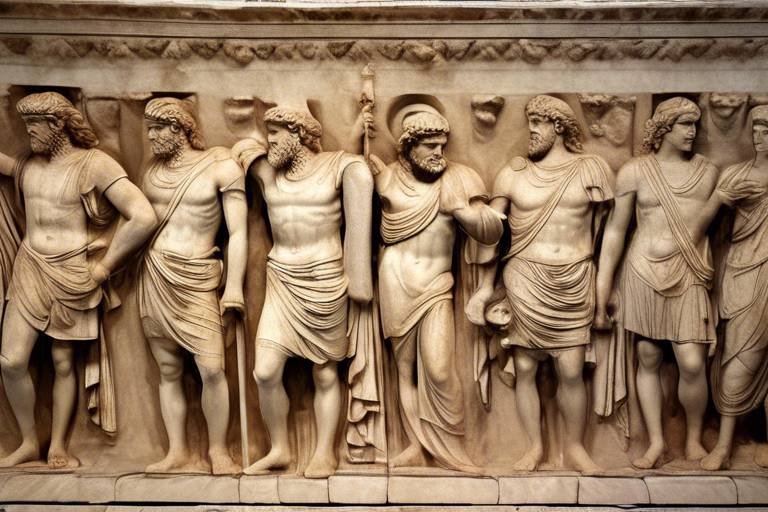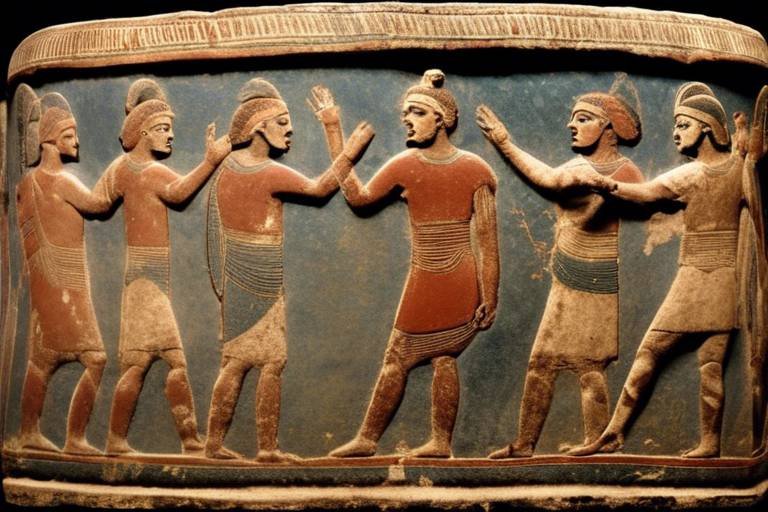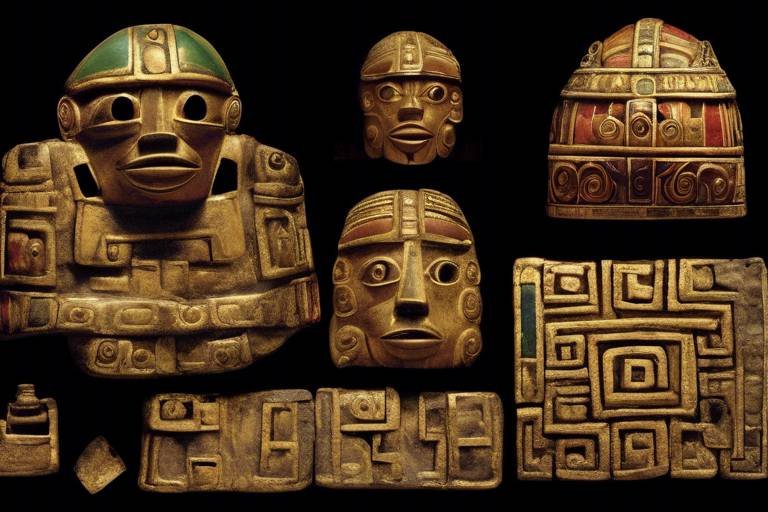The Cultural Richness of the Ashanti Kingdom
Step into the vibrant world of the Ashanti Kingdom, a place where culture thrives and traditions are deeply rooted in every aspect of life. From elaborate ceremonies to symbolic art, this West African kingdom is a treasure trove of cultural richness waiting to be explored.
Founded in the 17th century, the Ashanti Kingdom has a storied history that intertwines with colonial powers and modern-day efforts to preserve its cultural heritage. Delve into the origins and evolution of this kingdom, and discover how it has withstood the test of time amidst changing landscapes.
One of the most striking aspects of Ashanti culture is its traditional clothing, adorned with intricate designs and meaningful symbols. The iconic Kente cloth and Adinkra symbols not only showcase the kingdom's artistic prowess but also convey deep-seated values and beliefs.
Storytelling is at the heart of Ashanti culture, with folklore and oral traditions weaving a tapestry of myths, legends, and proverbs that have been passed down through generations. These tales not only entertain but also serve as a means to preserve history and impart moral lessons.
Religious practices in the Ashanti Kingdom offer a glimpse into the spiritual beliefs of its people. From the worship of deities to ancestral veneration, rituals associated with important life events and ceremonies play a significant role in shaping the cultural landscape of the kingdom.
Food is not just sustenance in Ashanti society; it is a reflection of their cultural identity. Experience the flavors of Ashanti cuisine, characterized by hearty stews, fufu, and plantains, and gain insight into the cultural significance of food in this vibrant community.
The artistic talents of Ashanti craftsmen are on full display in their intricate gold jewelry, wood carvings, and brass sculptures. These masterpieces not only showcase the kingdom's craftsmanship but also highlight the creativity and skill of its artisans.
Music and dance are integral parts of Ashanti culture, with rhythmic beats and energetic performances that celebrate their heritage. From traditional drumming ceremonies to vibrant cultural displays, immerse yourself in the lively sounds and movements of the Ashanti people.
As the world evolves, so do the challenges facing the preservation of Ashanti culture. Globalization and urbanization present modern hurdles, but efforts to safeguard and promote the kingdom's cultural traditions continue to ensure a legacy for future generations.

History of the Ashanti Kingdom
The history of the Ashanti Kingdom is a captivating tale of resilience, power, and cultural richness that dates back to the 17th century. Founded by King Osei Tutu, the kingdom quickly rose to prominence through strategic alliances and military conquests, establishing itself as a dominant force in the region.
One of the defining moments in Ashanti history was the legendary Golden Stool, a sacred symbol believed to hold the soul of the Ashanti nation. The Golden Stool united the Ashanti people and became a powerful emblem of their independence and sovereignty.
Throughout its history, the Ashanti Kingdom faced numerous challenges, including conflicts with colonial powers such as the British. Despite periods of colonization and resistance, the Ashanti people managed to preserve their cultural identity and traditions, showcasing their unwavering spirit and determination.
Today, the Ashanti Kingdom continues to honor its past while embracing modernity, striking a delicate balance between tradition and progress. Efforts to preserve the kingdom's heritage are ongoing, ensuring that future generations can appreciate the legacy of this remarkable civilization.

Traditional Ashanti Clothing
The traditional clothing of the Ashanti people is a vibrant reflection of their cultural identity and heritage. One of the most iconic elements of Ashanti clothing is the Kente cloth, a handwoven fabric adorned with intricate patterns and colors that hold symbolic meanings. Each Kente design carries a story or message, making it not just a garment but a form of visual communication.
Additionally, Adinkra symbols are another significant aspect of traditional Ashanti clothing. These symbols are stamped or embroidered onto fabrics to convey proverbs, historical events, or philosophical ideas. Each Adinkra symbol has a specific meaning and represents a concept that is deeply rooted in Ashanti culture.
Men and women in the Ashanti Kingdom wear distinct clothing styles, with men often donning tunics and trousers made from Kente cloth, while women wear wraparound skirts and tops with matching headscarves. The colors and patterns of the clothing can indicate the wearer's social status, clan affiliation, or the occasion they are attending.
Furthermore, the craftsmanship and artistry involved in creating traditional Ashanti clothing are highly revered. The weaving of Kente cloth and the intricate embroidery of Adinkra symbols require skill and precision, passed down through generations of Ashanti weavers and artisans.
Overall, traditional Ashanti clothing is not just about fashion but a means of expressing cultural pride, identity, and heritage. It serves as a visual representation of the values, beliefs, and history of the Ashanti people, showcasing the richness and diversity of their cultural traditions.

Ashanti Folklore and Oral Traditions
Exploring the mystical world of Ashanti folklore and oral traditions is like embarking on a journey through time, where stories come alive and wisdom is passed down from generation to generation. The Ashanti people have a rich tapestry of myths, legends, and proverbs that form the cultural backbone of their society. These tales not only entertain but also educate, instilling values and morals in the hearts of listeners.
One of the most famous aspects of Ashanti folklore is the Anansi stories, featuring the clever spider Anansi who outwits his opponents through cunning and wit. These stories serve as a reminder of the importance of intelligence and resourcefulness in overcoming challenges, a lesson that resonates with both young and old alike.
Moreover, the oral traditions of the Ashanti people include epic narratives that recount the heroic deeds of legendary figures such as Okomfo Anokye, a powerful priest who is said to have conjured a magical sword from the sky. These tales not only entertain but also serve as a means of preserving history and cultural heritage, ensuring that the legacy of the Ashanti Kingdom lives on.
Proverbs also play a significant role in Ashanti oral traditions, offering nuggets of wisdom and insight into the values cherished by the community. From "The one who fetches water will eventually break the pot" to "The ruin of a nation begins in the homes of its people," these proverbs encapsulate the essence of Ashanti philosophy and provide guidance for daily life.
Through the art of storytelling, the Ashanti people keep their traditions alive, passing down knowledge and wisdom from one generation to the next. It is through these tales that the spirit of the Ashanti Kingdom continues to thrive, connecting the past with the present and ensuring that the legacy of their ancestors endures for eternity.

Religious Practices in the Ashanti Kingdom
Exploring the vibrant cultural heritage and traditions of the Ashanti Kingdom in Ghana, known for its elaborate ceremonies, symbolic art, and historical significance in West Africa.
Delve into the origins and evolution of the Ashanti Kingdom, from its establishment in the 17th century to its interactions with colonial powers and modern-day cultural preservation efforts.
Discover the intricate designs and meanings behind traditional Ashanti clothing, including the iconic Kente cloth and Adinkra symbols that reflect the kingdom's values and beliefs.
Explore the rich storytelling traditions of the Ashanti people, including myths, legends, and proverbs passed down through generations to preserve history and teach moral lessons.
When delving into the religious practices of the Ashanti Kingdom, one encounters a deep connection to spirituality and tradition. The Ashanti people hold strong beliefs in the worship of deities and ancestral veneration. Rituals associated with important life events and ceremonies play a significant role in their spiritual practices.
Experience the flavors and ingredients of Ashanti cuisine, characterized by hearty stews, fufu, and plantains, as well as the cultural significance of food in Ashanti society.
Appreciate the artistic talents of Ashanti craftsmen, known for their intricate gold jewelry, wood carvings, and brass sculptures that showcase the kingdom's craftsmanship and creativity.
Immerse yourself in the rhythmic beats and energetic dances of the Ashanti people, from traditional drumming ceremonies to vibrant cultural performances that celebrate their heritage.
Examine the contemporary issues facing the preservation of Ashanti culture, including globalization, urbanization, and efforts to safeguard and promote the kingdom's cultural traditions for future generations.

Ashanti Cuisine and Culinary Traditions
Ashanti cuisine is a vibrant reflection of the rich cultural tapestry of the Ashanti Kingdom in Ghana. The culinary traditions of the Ashanti people are deeply rooted in their history, values, and beliefs, making every meal a celebration of heritage and community. One of the most iconic elements of Ashanti cuisine is the use of hearty stews, which are often made with a variety of meats, vegetables, and spices to create flavorful and satisfying dishes.
Ashanti cuisine also prominently features fufu, a staple food made from pounded cassava, plantains, or yams, which is served with soups or stews. The preparation of fufu is a labor-intensive process that requires skill and strength, emphasizing the importance of communal dining and shared meals in Ashanti culture. Additionally, plantains are a versatile ingredient in Ashanti cuisine, used in both savory and sweet dishes to add depth of flavor and texture.
Food plays a significant role in Ashanti society, serving as a symbol of hospitality, generosity, and unity. Meals are often shared with family and friends, reinforcing social bonds and fostering a sense of belonging within the community. The act of preparing and sharing food is considered an expression of love and respect, with each dish telling a story of tradition and identity.
Furthermore, the cultural significance of food extends beyond nourishment, with certain dishes and ingredients holding symbolic meanings related to spirituality, history, and social status. For example, the use of specific spices or herbs in Ashanti cuisine may be tied to traditional healing practices or ancestral rituals, adding a layer of depth and complexity to the dining experience.
In addition to the flavors and ingredients, the presentation of food in Ashanti cuisine is also an art form, with attention to detail and aesthetics playing a crucial role in meal preparation. Decorative elements such as colorful garnishes, intricate serving dishes, and elaborate table settings further enhance the sensory experience of dining, elevating it to a cultural expression of creativity and craftsmanship.

Art and Craftsmanship in the Ashanti Kingdom
Art and craftsmanship hold a special place in the heart of the Ashanti Kingdom, reflecting the kingdom's rich cultural heritage and creativity. Ashanti craftsmen are renowned for their exquisite skills in creating intricate gold jewelry, wood carvings, and brass sculptures that showcase the kingdom's craftsmanship and artistic prowess. These artisans meticulously handcraft each piece, infusing it with symbolism and cultural significance that resonate with the traditions and values of the Ashanti people.
The artistry of the Ashanti Kingdom extends beyond mere aesthetics; it serves as a means of storytelling and cultural expression. Each piece of artwork carries with it a narrative, whether it be a symbol of status, a representation of spiritual beliefs, or a reflection of historical events. The intricate designs and attention to detail in Ashanti craftsmanship are a testament to the dedication and skill of the artisans, who pass down their knowledge from generation to generation, ensuring the preservation of their cultural legacy.
One of the most iconic forms of Ashanti craftsmanship is the production of gold jewelry, which holds a significant cultural and economic value. The intricate patterns and designs of Ashanti gold jewelry symbolize wealth, power, and prestige within the community. The craftsmanship involved in creating these pieces is a meticulous process that requires precision and expertise, resulting in stunning works of art that are treasured both locally and internationally.
In addition to gold jewelry, wood carvings play a vital role in Ashanti art and craftsmanship. Skilled woodcarvers use traditional techniques to create intricate masks, figurines, and furniture that embody the cultural identity of the Ashanti people. These carvings often depict ancestral spirits, mythological creatures, and historical figures, serving as a visual representation of the kingdom's folklore and traditions.
Brass sculptures are another hallmark of Ashanti craftsmanship, with artisans employing age-old techniques to create elaborate pieces that adorn palaces, shrines, and public spaces. These sculptures often depict scenes from Ashanti mythology, historical events, and everyday life, showcasing the diverse artistic talent and creativity of the kingdom's craftsmen.
Overall, the art and craftsmanship of the Ashanti Kingdom are not merely decorative; they are a reflection of the kingdom's cultural identity, history, and values. Through their intricate creations, Ashanti artisans continue to preserve and celebrate their heritage, ensuring that the legacy of their craftsmanship endures for future generations to admire and appreciate.

Music and Dance of the Ashanti People
The music and dance of the Ashanti people are deeply intertwined with their cultural identity, serving as vibrant expressions of their heritage and traditions. The rhythmic beats of traditional drumming ceremonies echo through the villages, inviting everyone to join in the celebration of life and community. These lively performances are not just for entertainment but also serve as a way to honor their ancestors and connect with the spiritual realm.
One of the most iconic instruments used in Ashanti music is the Fontomfrom drums, large drums carved from a single piece of wood and played with sticks. The intricate patterns of the drumming rhythms communicate messages and stories, creating a powerful auditory experience that captivates both participants and spectators alike. The energetic movements of the dancers mirror the dynamic rhythms, evoking a sense of unity and joy among the community.
Traditional Ashanti dances are a colorful display of artistry and skill, with each movement symbolizing a specific aspect of their history or beliefs. The Adowa dance, for example, is a graceful performance that pays homage to the bravery and strength of the Ashanti warriors. Through synchronized movements and elaborate costumes, the dancers embody the spirit of resilience and pride that defines the Ashanti people.
Music and dance play a vital role in social gatherings and ceremonies within the Ashanti community, fostering a sense of belonging and shared cultural identity. Whether it's a joyous festival or a solemn ritual, the rhythms and movements of Ashanti music and dance serve as a powerful link to their past and a celebration of their enduring traditions.

Modern Challenges and Preservation Efforts
The Ashanti Kingdom, like many other cultural heritages around the world, faces modern challenges that threaten its preservation. In the face of globalization and urbanization, the traditional practices and values of the Ashanti people are at risk of being overshadowed by modern influences. The younger generation, exposed to Western culture through media and technology, may be drifting away from their roots, posing a challenge to the continuity of Ashanti traditions.
Efforts to preserve the cultural richness of the Ashanti Kingdom are underway, led by community leaders, cultural institutions, and dedicated individuals. Initiatives such as cultural festivals, educational programs, and heritage sites aim to raise awareness and appreciation for Ashanti traditions. By documenting oral histories, promoting traditional crafts, and encouraging youth involvement, these preservation efforts seek to ensure that the legacy of the Ashanti Kingdom endures for generations to come.
Frequently Asked Questions
- What is the significance of Kente cloth in Ashanti culture?
Kente cloth holds great cultural significance in Ashanti society. It is not just a fabric but a symbol of tradition, history, and social status. Each color and pattern in Kente cloth has a specific meaning, representing values, proverbs, or historical events.
- How are Adinkra symbols used in Ashanti culture?
Adinkra symbols are visual representations of concepts and aphorisms developed by the Ashanti people. These symbols are often found in clothing, pottery, and architecture, conveying messages of wisdom, life lessons, and cultural heritage.
- What are some common Ashanti proverbs and their meanings?
Ashanti proverbs play a crucial role in preserving the wisdom and traditions of the culture. Proverbs like "The ruin of a nation begins in the homes of its people" emphasize the importance of family and community values in Ashanti society.
- How is traditional Ashanti cuisine prepared?
Ashanti cuisine is known for its rich flavors and hearty dishes. Staples like fufu, a pounded cassava and plantain dish, are often served with spicy stews or soups. The preparation involves intricate cooking techniques and communal dining practices.
- What role does music play in Ashanti cultural celebrations?
Music is an integral part of Ashanti cultural events and ceremonies. Traditional drumming, dance, and songs are used to mark important occasions, express emotions, and connect with ancestral spirits, creating a vibrant and rhythmic atmosphere.



















